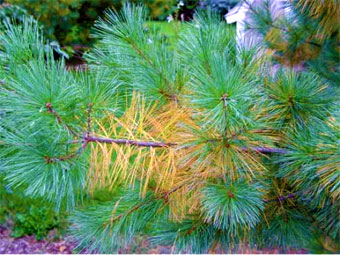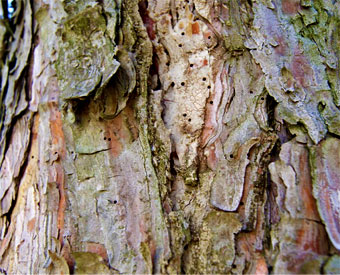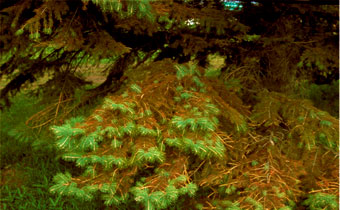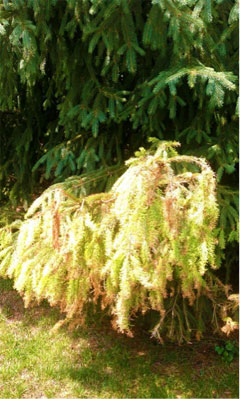Wondering what’s happening with your evergreen tree this fall? Take a look at our list and see if any might fit your situation.
10.) Your tree is a bald cypress which is deciduous, it’s supposed to lose needles in the fall and grow new ones in the spring.
9.) The needles that your evergreen tree is losing are 4 and 5 years old. Old needles are less productive than newer needles, so in the Fall most conifers shed old needles that aren’t contributing to the photosynthetic uptake of the tree.

8.) Your tree received little to no supplemental watering during one of the hottest and dryest years in Kansas City history making it susceptible to bark beetle attack; emergence holes indicate how much damage has been done. If you see holes (pin head size), plan on replacing the tree. If you don’t see the holes or if you see pitch/sap coming out of the holes, water your tree and apply a plant protectant next spring to control any bark beetles that may be attracted to it.

7.) You planted your conifer tree 10 years old, covered the root ball with landscape fabric, put limestone rock mulch on top of the fabric and surrounded your tree with landscape edging. New planting sites are a harsh environment for trees to survive in. Compacted clay soil reduces the growth of new roots and landscape fabric prevents water and nutrients from getting to the root system of the tree. In addition, limestone rock holds heat that can damage roots and as water runs over the rock it raises the pH of the soil which limits the availability of nutrients to the already stressed roots of the tree. When a tree can’t support itself with its root system it will drop needles. Remove the rock, fabric and edging and add organic mulch to the soil to help the roots survive and the tree to thrive.

6.) Your in-ground irrigation system has been hitting the branches of your tree, covering the needles of with water and creating a great environment for diseases like rhizospheara, sirrococcus, dothistroma, lirula and lophodermium needles casts . The only way to prevent the disease is to reduce the moisture contacting the needles and/or treating with preventative fungicide treatments next spring.
5.) You put a patio around the trunk of the tree, or did some other home remodeling/construction project that removed or damaged a majority of the root system of your tree. By removing or damaging tree roots, you remove it’s energy reserves that support everything above ground, you will lose needles and likely the whole tree.
4.) You have damage due to herbicide injury from a new lawn care product, “Imprellis®”, that was pulled from the market this summer. Check with your lawn care provider to see if they used the product. If they did, you can have them submit a claim to compensate you for the damage to your tree. Most of the problems we observed this year were on white pine and Norway Spruce.

3.) Your tree is THIRSTY. September & October were the driest Fall in recent history. Although we had an overabundance of rain this spring, it didn’t carry over in the Fall. Conifer roots need moisture going into the winter, without it trees will drop the needles it can no longer support. Make sure to provide supplemental water to your trees this fall.
2.) Your pine tree has died due to Pine Wilt Disease and is in dire need of removal in order to help prevent the spread to other susceptible species including Scots, Austrian, and occasionally white pine.

1.) It was last year’s Christmas tree and you should have recycled it A LONG TIME AGO 🙂
Still can’t figure it out? Give us a call and one of our certified arborists can stop by to help.









